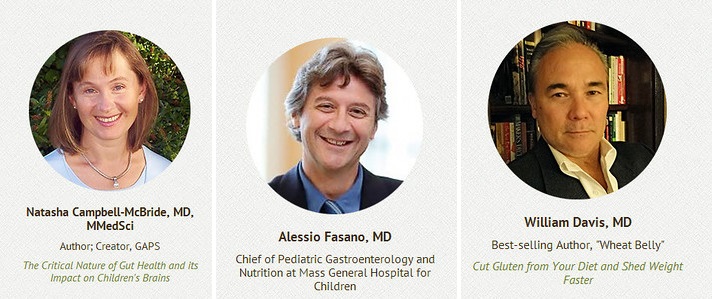
I’m excited and delighted to announce to my patients and readers the upcoming FREE online worldwide symposium on gluten from November 11–17, 2013.
You can register for this free seminar by clicking this link. Each day during that week four or five interviews will be available to listen to during each 24 hour period. For those of you who will want to listen to the interviews on your smart phones, there will be the option to purchase the downloads. But, that it not at all expected if you just want to listen online.
I am seeing what could be called “miracles” in my practice by discovering a patient has gluten sensitivity and taking them off gluten. My most recent “miracle” occurred when I found gluten sensitivity in a 35-year-old woman with Multiple Sclerosis, who has had blurred vision for six months. This is after seeing many neurologists. Two weeks after taking her off gluten, her blurred vision disappeared and has remained gone.
During the upcoming summit, Dr. Tom O’Bryan, who is the gluten expert that I interviewed on one of my podcasts, will be interviewing some of the most famous gluten researchers in the world.
This FREE seminar series will be great for some of your friends who may be skeptical of the importance of gluten sensitivity by calling it a “fad” diet. During the conference you will learn the science behind all the information showing the gluten can be a problem for many people.
Some of the doctors who will be interviewed include
William Davis, M.D.
David Perlmutter, M.D.
Alessio Fasano, M.D.
Umberto Volta, M.D.
and Michael Marsh, M.D., the doctors who have brought to our attention the importance of recognizing gluten sensitivity.
I urge all my patients and readers who have any interest whatsoever in gluten sensitivity to tune into at least part of this summit. All aspects of Gluten sensitivity will be discussed!
Full information and Registration can be done at this site.
I look forward to being in dialogue with you about gluten and our health.



.aspx?width=190&height=250) Sprouts are tiny, baby plants that are just beginning their journey into the familiar veggies we know. Yet, at this stage the sprout is packed with high concentrations of vitamins, minerals, amino acids and more, which it will need to grow into a mature plant.
Sprouts are tiny, baby plants that are just beginning their journey into the familiar veggies we know. Yet, at this stage the sprout is packed with high concentrations of vitamins, minerals, amino acids and more, which it will need to grow into a mature plant. Accidents are the leading cause of death among toddlers, so keeping your home baby-proof is an essential part of being a parent, grandparent or anyone who has babies and toddlers who visit their home.
Accidents are the leading cause of death among toddlers, so keeping your home baby-proof is an essential part of being a parent, grandparent or anyone who has babies and toddlers who visit their home..aspx?width=169&height=250) What does it take to live to be 100, or even 91? Ask a handful of centenarians, and you’re likely to get a handful of different answers.
What does it take to live to be 100, or even 91? Ask a handful of centenarians, and you’re likely to get a handful of different answers.

 Every year, 1.3 million Americans undergo LASIK surgery to correct their vision, and most have good results. In fact, only 2 percent to 3 percent of LASIK (which stands for Laser-Assisted In-Situ Keratomileusis) patients have complications, according to the American Society of Cataract and Refractive Surgery.
Every year, 1.3 million Americans undergo LASIK surgery to correct their vision, and most have good results. In fact, only 2 percent to 3 percent of LASIK (which stands for Laser-Assisted In-Situ Keratomileusis) patients have complications, according to the American Society of Cataract and Refractive Surgery. It’s no secret that America is renowned for being the pill-popping “Prozac Nation” trying to medicate its problems with a host of ‘miracle drugs’ that constitute a billion-dollar industry.
It’s no secret that America is renowned for being the pill-popping “Prozac Nation” trying to medicate its problems with a host of ‘miracle drugs’ that constitute a billion-dollar industry. Every five minutes, someone in the United States is killed by an accident, according to new research from The National Safety Council (NSC). Overall, accidents are the fifth leading cause of death, behind only heart disease, cancer, stroke and chronic lower respiratory diseases.
Every five minutes, someone in the United States is killed by an accident, according to new research from The National Safety Council (NSC). Overall, accidents are the fifth leading cause of death, behind only heart disease, cancer, stroke and chronic lower respiratory diseases. About 10 million people in the United States suffer from fibromyalgia, a syndrome characterized by chronic widespread pain, sleep disturbances, fatigue and, often, psychological distress as a result. Of them, about 75-90 percent are women, according to the National Fibromyalgia Association (NFA).
About 10 million people in the United States suffer from fibromyalgia, a syndrome characterized by chronic widespread pain, sleep disturbances, fatigue and, often, psychological distress as a result. Of them, about 75-90 percent are women, according to the National Fibromyalgia Association (NFA).





